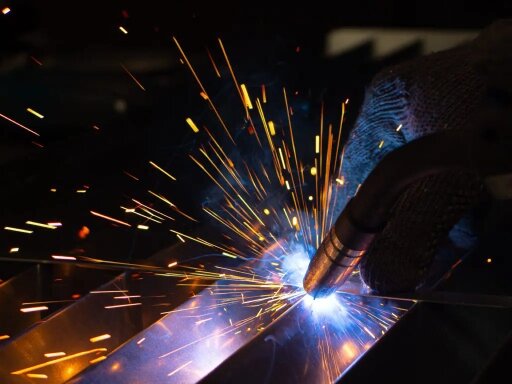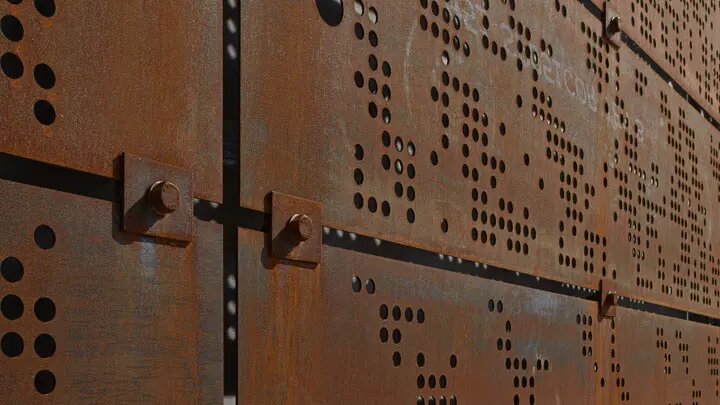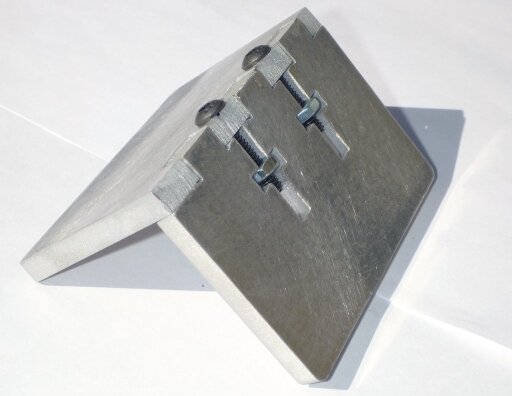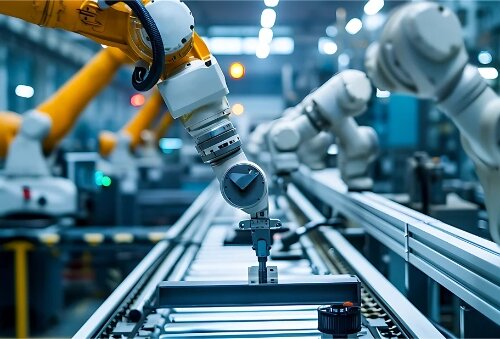Clear communication is one of the most potent tools in sheet metal fabrication. Even one misunderstood word can shift a bend by a millimeter, misalign a hinge, or cause a part to fail during assembly. Engineers may design with one definition in mind while the shop follows another. When this happens, quotes become inaccurate, samples need rework, and production slows down.
Many teams encounter these issues without realizing the underlying cause. A buyer might request a “tight tolerance,” but the term means different things to different factories. An engineer might set a bend radius that appears fine on screen, but the material cracks during the forming process. These problems often resemble manufacturing errors, but the root cause is frequently found in unclear terminology used during the design stage.
The goal of this guide is to prevent these gaps. The sections below explain the sheet metal terms that influence cost, accuracy, and long-term performance. Each term appears daily on shop floors, in design reviews, and in RFQs.

Design and DFM Terms
Good designs depend on understanding how metal behaves when it bends or forms. The following terms help teams avoid cracking, warping, and dimensional drift during fabrication.
شعاع الانحناء
نصف قطر الانحناء is the inner radius formed when metal bends. It affects cracking, stretch, and final strength. A radius that is too small forces the material to stretch beyond its limits, especially in stainless steel or aluminum.
Most projects start with a radius equal to 1× material thickness. More complex alloys—such as stainless steel or high-strength steel—often need 1.5× to 2×. A correct radius reduces springback and helps form cleaner, more precise angles.
مثال على ذلك:
A 1.0 mm stainless steel bracket with a 0.5 mm radius often cracks at the bend line. Increasing the radius to 1.0–1.5 mm usually removes the issue.
عامل K
The K-factor determines the location of the neutral axis during bending. This axis does not stretch or compress. Its position determines how much the material elongates.
Air bending typically yields K-factors ranging from 0.3 to 0.5. Bottoming or coining compresses the metal more deeply, pushing the neutral axis inward. Using the correct K-factor ensures accurate flat pattern lengths and prevents holes from shifting after bending.
Real-world use:
Incorrect K-factors are one of the most common reasons flat patterns do not match finished parts.
بدل الانحناء وخصم الانحناءات
Bend allowance (BA) measures the arc length created by the bend. Bend deduction (BD) compensates for how much flange length must change to achieve accurate dimensions.
Both values depend on thickness, radius, angle, and the K-factor. Incorrect BA or BD leads to mismatched edges, doors that do not close, or tabs that do not line up. Accurate values reduce the time needed for prototype tuning.
ما أهمية ذلك:
A 0.2 mm error in BA on a single bend can multiply across multiple bends in an enclosure.
Flange Length
Flange length is the straight section that extends from a bend. Press brakes require a minimum flange length for secure clamping. A standard guideline is:
Minimum flange = 4× thickness + bend radius
Shorter flanges can slip during bending or cause interference with tooling. Proper flange length ensures stable, repeatable forming.
مثال على ذلك:
A 1.5 mm steel part with a 3 mm flange is often impossible to form without special tooling.
Tolerance and Tolerance Stack-Up
Tolerance defines acceptable variation for a dimension. Sheet metal forming often uses tolerances of ±0.1 mm to ±0.3 mm, depending on the geometry and process.
Tolerance stack-up refers to the accumulation of minor variations across multiple features. Even if each dimension stays within spec, the combined error can cause misalignment in hinges, mounting holes, or PCB locations.
Why stack-up matters:
In a large enclosure, a 0.2 mm variation in five locations can result in a 1.0 mm misalignment at the final assembly step.
الربيع العودة
الربيع العودة happens when metal relaxes after bending and returns slightly toward its original shape. Stainless steel, high-strength steel, and aluminum often show more springback than mild steel.
Values typically range from 1° to 5°, depending on thickness, angle, tooling, and alloy. Designers compensate by over-bending or adjusting tooling. Planning for springback improves consistency across all batches.
Practical insight:
Ignoring springback is one of the most common causes of inconsistent angles between prototypes and mass-produced parts.
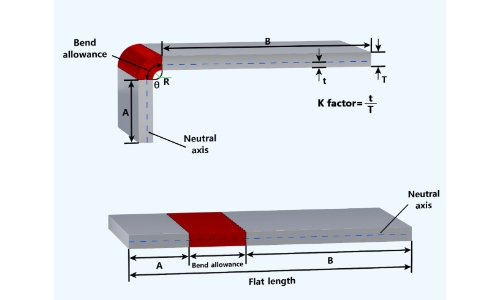
Material and Thickness Terms
Material choice impacts strength, corrosion resistance, weight, and the ease with which the part forms. These terms help teams select the right sheet for both function and cost.
Gauge vs. Thickness
كَيّل is a numbered system used to describe thickness, but gauge values change between materials.
مثال على ذلك:
- 16-gauge steel ≈ 1.52 mm
- 16-gauge aluminum ≈ 1.29 mm
Because gauge varies by alloy, most factories prefer using millimeters or inches. Direct thickness values remove confusion and make bending and welding more predictable.
Pain point:
Every year, factories receive drawings using the wrong gauge system. This leads to incorrect bending results and delayed quotes.
Alloy Types
Different alloys exhibit varying behaviors during cutting, forming, and welding.
- الفولاذ الطري bends easily, welds cleanly, and is a cost-effective material.
- الفولاذ المقاوم للصدأ resists corrosion but often requires larger bend radii and more power during cutting.
- الألومنيوم is lightweight and corrosion-resistant, but softens under heat if welding is not controlled.
مثال على ذلك:
A stainless steel hinge bracket with small internal radii often cracks unless the radius is increased or annealed material is used.
Choosing the right alloy enables teams to effectively balance strength, durability, cost, and appearance.
اتجاه الرمل
Grain direction comes from the rolling process.
- الانحناء parallel to the grain increases the risk of cracking.
- الانحناء across the grain improves ductility and produces smoother results.
This is particularly critical for aluminum alloys such as 5052 and 6061.
مثال على ذلك:
A 6061 panel bent parallel to the grain at a sharp angle often forms cracks. Rotating the part 90° resolves the issue without altering the thickness.
Remnant
A remnant is the leftover sheet after all parts have been cut. Remnants depend on how well parts are nested. Better nesting reduces waste and lowers material cost.
In high-volume orders, remnant planning affects profitability. Buyers who ask about remnant usage often receive more accurate quotes.
مثال على ذلك:
Switching from poor nesting to optimized nesting often saves 3–8% of material on significant parts.
Cutting and Forming Terms
Cutting defines the shape. Forming turns the flat pattern into a three-dimensional part. These terms explain the processes that influence accuracy and finish quality.
القطع بالليزر
القطع بالليزر uses a focused beam to create precise shapes. Typical tolerances range from ±0.1 to ±0.2 mm, depending on the material and thickness.
Lasers produce clean edges and can handle complex shapes without the need for special tooling. They are ideal for prototypes, mixed batches, and detailed designs.
Pain point:
Designs with sharp internal corners may overheat or create micro-cracks. Adding a small radius solves the problem.
Punching / CNC Turret Punching
اللكم uses a tool and die to mechanically cut or form shapes. It is fast and cost-effective for high-volume orders, particularly for repeated patterns such as louvers and knockouts.
Punching is more cost-effective at scale, but it requires the correct punch sizes to be used. Large or custom shapes may require new tooling.
مثال على ذلك:
A ventilation panel with hundreds of identical slots is usually cheaper to punch than laser cut.
إزالة الأزيز
Deburring removes sharp edges left from cutting. It improves safety, facilitates smooth part assembly, and ensures strong adhesion for paint or powder coating.
Factories use brushing, tumbling, grinding, or automated deburring machines to process materials. Skipping this step leads to coating defects and safety risks.
Hem
A hem is a folded edge that increases stiffness and removes sharp edges. It is common on doors, covers, and support brackets.
Proper hem width prevents cracking. Designs that utilize hems achieve better safety and a cleaner appearance without increasing material thickness.
Ribs and Louvers
Ribs stiffen panels without adding weight. Louvers allow airflow while keeping strength.
These features require special tooling. They are widely used in electrical enclosures, HVAC systems, and machine guards.
مثال على ذلك:
A 1.2 mm panel with ribs can match the stiffness of a 2.0 mm flat panel, reducing both weight and cost.
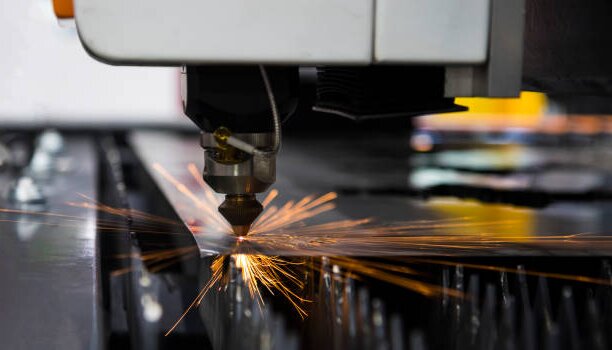
Welding and Joining Terms
Joining turns separate pieces into a complete assembly. Choosing the correct method depends on strength needs, appearance, and production speed.
تيج لحام
TIG welding offers clean, precise joints with minimal spatter. It is ideal for stainless steel and aluminum.
It produces high-quality welds but requires more time than MIG welding. TIG is often used for visible surfaces, medical parts, and high-value components.
مثال على ذلك:
A cosmetic stainless enclosure almost always uses TIG to achieve smooth corner seams.
لحام ميغ
MIG welding uses a continuous wire feed. It is faster than TIG and works well on thicker steel parts.
It is widely used for frames, heavy brackets, and industrial enclosures. MIG welds are strong but may not offer the same finish quality as TIG.
اللحام البقعي
Spot welding joins two sheets by applying pressure and electrical current at a single point. It is fast, repeatable, and cost-effective.
It works best for overlapping joints and consistent thickness. It is used in cabinets, automotive parts, and metal doors.
Hardware Installation
Self-clinching hardware adds threads to thin sheet metal. Common types include nuts, studs, and standoffs.
Correct hole size and sheet thickness are critical. When properly installed, hardware stays firmly in place and provides strong support for PCBs and covers.
Tabs and Slots
Tabs and slots help align parts during welding or assembly. They reduce fixtures, speed up production, and improve accuracy.
Factories often build tab-and-slot features into enclosures and frames to guide parts into place.
Pain point:
Without alignment features, welders often spend extra time manually adjusting parts.
Finishing Terms
Finishing protects parts from corrosion, improves appearance, and affects dimensional fit. The right finish depends on the environment and the design requirements.
مسحوق الطلاء
Powder coating is a dry, electrostatic finishing method that forms a rigid, corrosion-resistant surface. Typical thickness ranges from 60 to 100 μm, depending on the material’s color and geometry.
It gives a uniform finish but adds measurable buildup around edges and holes. Designers must consider this to avoid interference during assembly.
مثال على ذلك:
A 5.0 mm hole may shrink to 4.8 mm after coating, which can affect the screw fit if not taken into account.
أنودة
أنودة strengthens the outer surface of aluminum and increases corrosion resistance. It also gives a stable, scratch-resistant finish.
Typical thickness ranges from:
- 5–15 μm for Type II (cosmetic)
- 20–25 μm for Type III (hard anodize)
Unlike powder coating, anodizing forms within the metal structure, which minimizes dimensional changes.
Use case:
Aluminum enclosures with tight hinge pins often opt for anodizing to prevent coating buildup.
Plating / Zinc Coating
Zinc plating protects steel from rust by creating a thin sacrificial layer. Even when scratched, zinc slows corrosion by oxidizing first.
Plating is thin and has almost no effect on tolerance. It is common for brackets, fasteners, and high-volume industrial components, where cost control matters.
Graining / Brushed Finish
Graining creates a directional brushed texture on stainless steel or aluminum. It hides fine scratches and improves appearance.
The finish is popular for appliances, control panels, and exposed surfaces. Matching grain direction across panels ensures a consistent look.
مثال على ذلك:
If a cabinet door and frame use different grain directions, the mismatch becomes visible under light.
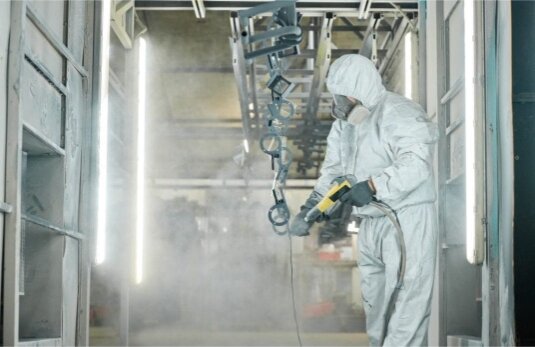
Quality and Inspection Terms
Quality terms define how accuracy, repeatability, and stability are measured and evaluated. These checks protect both performance and cost.
FAI (First Article Inspection)
A First Article Inspection verifies that the first produced part matches the approved drawing. It checks every critical dimension, material, and forming feature.
FAI is essential for new designs, assemblies with mating parts, and products with tight tolerances. It prevents large batches from being produced incorrectly.
Flatness / Perpendicularity
Flatness ensures that a surface is even and not warped. Perpendicularity checks if two surfaces meet at a precise 90° angle.
Poor flatness can cause assembly gaps, light leaks, or PCB mounting issues. Poor perpendicularity can cause misalignment of doors or result in gaps in enclosures.
Cpk / Process Capability
Cpk measures how consistently a production process stays within tolerance. A process with a Cpk value of 1.33 or greater is considered stable for most industries.
This metric enables buyers to assess the reliability of suppliers. High Cpk values reduce scrap rates, rework, and hidden quality risks.
مثال على ذلك:
A bending process with a low Cpk produces varying angles throughout the day, resulting in assembly issues.
Go / No-Go Fixtures
Go/No-Go fixtures offer fast pass-or-fail checks for key dimensions. They are common in high-volume production because they reduce inspection time.
These fixtures help maintain consistent quality and prevent defective parts from moving downstream.
Production and Tooling Terms
These terms explain how projects scale from prototypes to repeatable production and how tooling choices affect cost and efficiency.
Prototype vs. Production
Prototype parts utilize flexible processes, such as laser cutting and manual welding. They support quick reviews and design updates.
Production parts require stable processes, fixtures, and consistent tooling. These reduce unit cost and improve repeatability once the design is locked.
Soft Tooling vs. Hard Tooling
Soft tooling utilizes simple, lower-cost tools that are suitable for small- to medium-batch production. It works well when designs are still in a state of flux.
Complex tooling utilizes durable dies specifically designed for extended production runs. It lowers unit costs at volume but requires a higher upfront investment.
مثال على ذلك:
A project with only 300–500 annual parts typically utilizes soft tooling, whereas a 10,000-piece order benefits from complex tooling.
Nesting
Nesting arranges parts on a sheet to reduce scrap. Good nesting improves material utilization by 3–15%, depending on geometry.
Better nesting lowers cost, reduces remnant waste, and improves delivery time.
حجم الدفعة
Batch size affects cost, setup time, production speed, and inventory control.
- Small batches = flexibility but higher unit cost
- Large batches = efficiency but less flexibility
Choosing the right size depends on design stability and demand planning.
خاتمة
Sheet metal fabrication works best when everyone uses the same technical language. When teams understand these terms, designs become easier to build, quotes align with real conditions, and production remains steady. This shared knowledge also helps prevent mistakes in bending, welding, forming, and finishing. It provides engineers, buyers, and manufacturers with a smoother way to collaborate.
If you want fewer revisions, cleaner bends, and faster lead times, our engineers can help. Share your drawings with us, and we’ll review the design, check the manufacturability, and return a detailed DFM report—free of charge.
مهلا، أنا كيفن لي

على مدى السنوات العشر الماضية، كنت منغمسًا في أشكال مختلفة من تصنيع الصفائح المعدنية، وشاركت رؤى رائعة هنا من تجاربي عبر ورش العمل المتنوعة.
ابقى على تواصل

كيفن لي
لدي أكثر من عشر سنوات من الخبرة المهنية في تصنيع الصفائح المعدنية، وتخصصت في القطع بالليزر، والثني، واللحام، وتقنيات معالجة الأسطح. كمدير فني في شنغن، أنا ملتزم بحل تحديات التصنيع المعقدة ودفع الابتكار والجودة في كل مشروع.

